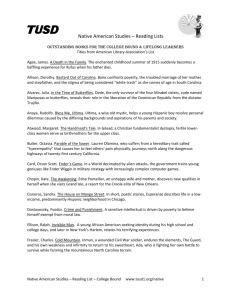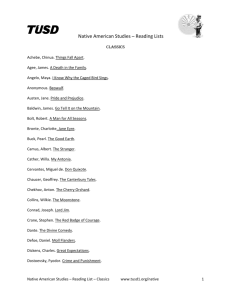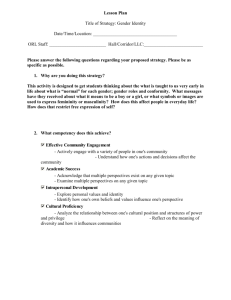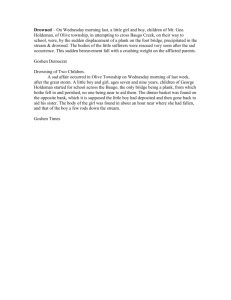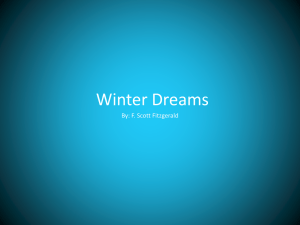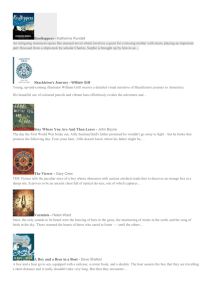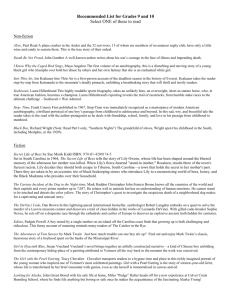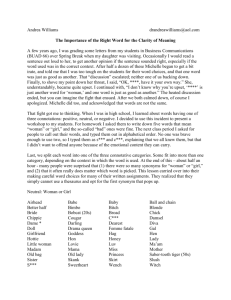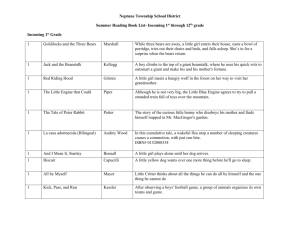TUSD Native American Student Services - Reading List
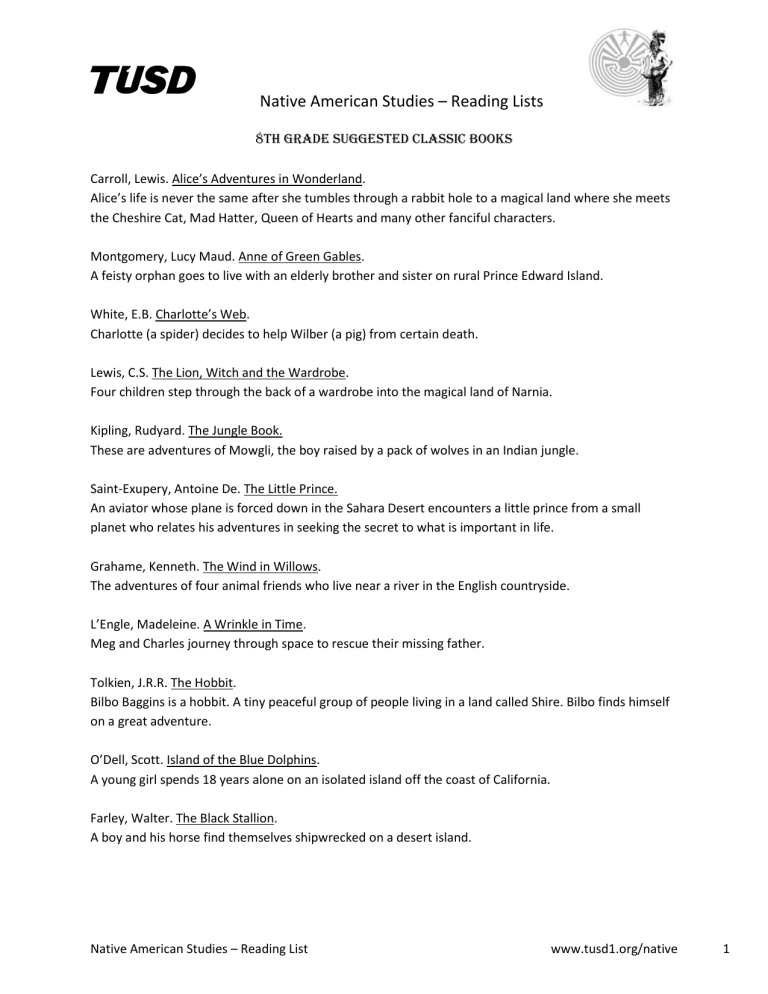
Native American Studies – Reading Lists
8th grade suggested classic books
Carroll, Lewis. Alice’s Adventures in Wonderland.
Alice’s life is never the same after she tumbles through a rabbit hole to a magical land where she meets the Cheshire Cat, Mad Hatter, Queen of Hearts and many other fanciful characters.
Montgomery, Lucy Maud. Anne of Green Gables.
A feisty orphan goes to live with an elderly brother and sister on rural Prince Edward Island.
White, E.B. Charlotte’s Web.
Charlotte (a spider) decides to help Wilber (a pig) from certain death.
Lewis, C.S. The Lion, Witch and the Wardrobe.
Four children step through the back of a wardrobe into the magical land of Narnia.
Kipling, Rudyard. The Jungle Book.
These are adventures of Mowgli, the boy raised by a pack of wolves in an Indian jungle.
Saint-Exupery, Antoine De. The Little Prince.
An aviator whose plane is forced down in the Sahara Desert encounters a little prince from a small planet who relates his adventures in seeking the secret to what is important in life.
Grahame, Kenneth. The Wind in Willows.
The adventures of four animal friends who live near a river in the English countryside.
L’Engle, Madeleine. A Wrinkle in Time.
Meg and Charles journey through space to rescue their missing father.
Tolkien, J.R.R. The Hobbit.
Bilbo Baggins is a hobbit. A tiny peaceful group of people living in a land called Shire. Bilbo finds himself on a great adventure.
O’Dell, Scott. Island of the Blue Dolphins.
A young girl spends 18 years alone on an isolated island off the coast of California.
Farley, Walter. The Black Stallion.
A boy and his horse find themselves shipwrecked on a desert island.
Native American Studies – Reading List www.tusd1.org/native 1
Native American Studies – Reading Lists
Bagnold, Enid. National Velvet.
A 14 year old English girl wins a horse in a raffle, trains it and rides in the Grand National Steeplechase.
Armstrong, William H. Sounder.
The story of a black sharecropper, his family and their loyal dog.
Burnett, Frances Hodgson. The Secret Garden.
Ten year old Mary goes to live in a lonely house on the Yorkshire Moors where she discovers a mysterious locked garden.
Juster, Norton. The Phantom Tollbooth.
Milo drives through a toll booth into a land of fantasy and adventure.
Konigsburg, E.C. From the Mixed up Files of Mrs. Basil E. Frankweiler.
Claudia and her younger brother run away to live in the Metropolitan Museum of Art.
George, Jean Craighead. Julie of the Wolves.
An adventure about 13 year old Julie and the wolf pack that adopts her in the Alaskan Tundra.
Taylor, Mildred. Roll of Thunder Hear My Cry.
Living in the South during the 1930’s, African American, Logan family faces devastating discrimination and prejudice.
O’Brien, Robert C. Mrs. Frisby and the Rats of Nimh.
Story of a field mouse widow who asks help from a group of rats and finds they are part of an experiment at the National Institute of Mental Health. Together they work a plan for a safer life.
Alcott, Louisa May. Little Women.
The four March sisters grow into young ladies against the back drop of Civil War era New England.
Dahl, Roald. James and the Giant Peach.
James escapes from his fearful aunts by rolling away inside a giant peach.
Spyri, Johanna. Heidi.
A Swiss orphan is heart broken when she must leave her beloved grandfather and their happy home to go to school and live in the City.
Rawls, Wilson. Where the Red Fern Grows.
Story follows an Ozark boy through his childhood with his two beloved dogs. They experience danger, adventure, love and sorrow.
Native American Studies – Reading List www.tusd1.org/native 2
Native American Studies – Reading Lists
Dahl, Roald. Charlie and the Chocolate Factory.
Each of five children lucky enough to discover an entry ticket into Mr. Willy Wonka’s mysterious chocolate factory takes advantage of the situation in his own way.
Curtis, Christopher Paul. The Watson’s Go to Birmingham: 1963.
In the height of the Civil Rights Movement, a family travels to Alabama and experiences racial injustice first hand, surviving through with love and humor.
Wells, H.G. Time Machine.
A scientist invents a time machine and then travels into the distant future.
Burnett, Frances Hodgson. A Little Princess.
When Sara Crews’ father dies, she finds herself left penniless and alone at a strict Victorian girl’s school.
Wilder, Laura Ingalls. Little House in the Big Woods.
Author recounts her memories of growing up in the Wisconsin frontier.
Estes, Eleanor. Hundred Dresses.
Tender story of a little girl who claims to have 100 beautiful dresses at home, yet she wears the same one to school every day.
Paulsen, Gary. Hatchet.
Brian survives a plane crash to find himself stranded alone on a wooded island.
Byars, Betsy. Summer of the Swans.
When Sara’s developmentally disabled brother disappears, she attempts to find him.
Sacher, Louis. Holes.
Stanley Yelnats life of bad luck takes him to a correctional camp where he meets a true friend, a treasure and a new sense of himself.
Hesse, Karen. Out of the Dust.
In a series of poems, fifteen year old Billie Jo relates the hardships of living on her family’s wheat farm in
Oklahoma during the dust bowl years of the depression.
Lowry, Lowis. The Giver.
Given his lifetime assignment at the ceremony of 12, Jonas becomes the receiver of memories shared by only one other in his community and discovers the truth of the society in which he lives.
Native American Studies – Reading List www.tusd1.org/native 3
Native American Studies – Reading Lists
Naylor, Phyllis Reynolds. Shiloh.
Marty tries to hide a lost beagle he finds from his family and the dog’s real owner, a mean spirited man known to mistreat dogs.
Sewell, Ann. Black Beauty.
A horse of 19th Century England tells his life story from his early home through many masters and experiences both good and bad.
Barrie, James M. Peter Pan.
The three Darling children fly away from their nursery with Peter Pan and travel to Never-Never Land.
Stevenson, Robert Lewis. Kidnapped.
David Balfour survives kidnapping, imprisonment, dangerous journeys and enemies in an exciting adventure.
Grahame, Kenneth. Reluctant Dragon.
The boy who finds the dragon in the cave knows it is kindly and harmless. How can he convince the villagers and St. George, the dragon killer?
Stevenson, Robert Louis. Treasure Island.
Jim Hawkins’ exploits in the 18th century involve a parrot and a treasure map.
Swift, Jonathan. Gulliver’s Travels.
An adventure about Gulliver and his travels to lands of miniature people, giants, and other odd creatures.
Anderson, Han Christian. Snow Queen.
Describes the adventures of a boy carried away by the Snow Queen and the search of the young girl who followed him.
Austin, Jane. Pride and Prejudice.
In early nineteenth-century England, a spirited young woman copes with the courtship of a snobbish gentleman as well as the lives of her four sisters.
Austin, Jane. Emma.
This novel of Regency England centers upon a self-assured young lady who is determined to arrange her life and the lives of those around her into a pattern dictated by her romantic fancy.
Native American Studies – Reading List www.tusd1.org/native 4
Baum, L. Frank. Wizard of Oz.
Native American Studies – Reading Lists
The story of Dorothy, a young girl who is transported by a cyclone to the magical world of Oz where she makes wonderful friends, battles evil, and must meet a Wizard to return home to Kansas.
Bradbury, Ray. Fahrenheit 451.
A book burner in a future fascist state finds out books are a vital part of a culture he never knew.
Bronte, Charlotte. Jane Eyre.
A young governess finds love unexpectedly with her new employer, but secrets from his past may prove to destroy her happiness.
GRADE 7 AND UP: NATIVE AMERICAN LITERATURE
Alexie, Sherman. Absolutely True Diary of a Part-Time Indian. Called “Junior” by his friends and relatives on the Spokane reservation and “Arnold” by the white people in the other part of the world he inhabits part-time, he’s an Indian boy coming into adulthood, literally weaving and dodging and rolling with the pun
Allen J. Sockabasin. An Upriver Passamaquoddy. Drawing on his memories and an oral tradition, Allen
Sockabasin returns to his Passamaquoddy village Mud-doc-mig-goog, or Peter Dana Point, near
Princeton, Maine. To the outside world they lived in poverty, but he remembers a life that was rich.
Armstrong, Jeannette. Slash. Through the fictionalized memoir of young Okanagan activist-by-chance
Tommy Kelasket—aka “Slash”—Armstrong puts a human face on the aboriginal struggle for land, culture and community.
Awiakta, Marilou. Abiding Appalachia: Where Mountain and Atom Meet. Awiakta’s poetry follows the trail of Awi Usdi, Little Deer, through the saga of Tsali and the Trail of Tears, through her own childhood when the atom was split in secret, and into the heart of the atom itself.
Beardslee, Lois. Lies to Live By. The 44 stories in this collection are not “retold” myths-and-legends. They are stories here from Beardslee’s own life, seamlessly interwoven with the traditional stories of her people.
Blue Cloud, Peter/Aroniawenrate. Clans of Many Nations: Selected Poems 1969-94. These poems, spanning 25 years in the life of one of the most prolific literary voices of Native people. Aroniawenrate’s poems are a treasure.
Native American Studies – Reading List www.tusd1.org/native 5
Native American Studies – Reading Lists
Bruchac, Joseph. No Borders. There are no borders between humans and the land we share with all creation, between the razor wire of a prison and the flying geese overhead, between the sweet maple syrup and the hard work of processing it.
Campbell, Maria. Halfbreed. One of the most important works of Indian literature in the 20th Century.
It’s a hard book to read. Of it, Campbell says, “I write this for all of you, to tell you what it is like to be a
Halfbreed woman in our country."
Carlson, Lori Marie, ed. Moccasin Thunder: American Indian Stories for Today. All of the narrators in these ten short stories are contemporary young Indian people, shakily standing on the precipice of adulthood, trying to figure out their place in the world, trying to figure out what truths the stories hold.
Confederated Salish and Kootenai Tribes. Salish People and the Lewis and Clark Expedition. On
September 4, 1805, dozens of lodges were set up in the Upper Bitterroot Valley in what is now called
“Montana.”
Conley, Robert J. Mountain Windsong: A Novel of the Trail of Tears. Conley tells the tragic story of two ordinary young people caught up in the removal from their traditional lands, and brings to life the suffering and endurance of the Cherokee people.
Dauenhauer, Nora Marks. Life Woven with Song. Dauenhauer is a mama, a grandma, a great-grandma, and a gifted writer, poet and storyteller who seamlessly weaves together memories of land, culture and community.
Deloria, Ella Cara. Waterlily. Waterlily, finished in 1947 and not published during Deloria’s life, is a novel, a life story of the Dakota people, as their lives were beginning to be disrupted by the wasichu.
Dumont, Marilyn. Really Good Brown Girl. A Really Good Brown Girl is a collection of poetry and memories about land, family, and the multiple boundaries imposed by the continuing colonization of the
Métis people.
Hogan, Linda. Mean Spirit. In the 1920s, the discovery of oil in Oklahoma on land belonging to the Osage people spurred a series of violent events designed to transfer tribal lands into the hands of the oil barons; a vicious campaign of fraud, intimidation, and murder by whites.
Hungry Wolf, Beverly. Ways of My Grandmothers. As a transmitter of traditional culture, Beverly Hungry
Wolf offers a tribute, an honoring, to her female elders and ancestors—from her grandmother and great-grandmother, to the oldest women of the tribe.
Native American Studies – Reading List www.tusd1.org/native 6
Native American Studies – Reading Lists
Kawano, Kenji. Warriors: Navajo Code Talkers. Through his long friendship with Navajo elder and Code
Talker Carl Gorman and his family, Japanese-born Kenji Kawano became the “official” photographer to the Navajo Code Talkers Association.
King, Thomas. One Good Story, That One. The ten stories in this collection—many of which are hilarious—are mischievously told, slyly exposing the underside of Native-white relations. Adolescents who don’t like to read will get caught up in these stories.
Sawyer, Don. Where the Rivers Meet. Where the Rivers Meet is primarily the story of a Shuswap teen who lives in a community targeted by racism and opportunism, and hampered by beaurocacy. The story touches on harsh realities.
Tapahonso, Luci. Blue Horses Rush In. Tapahonso dedicates Blue Horses to her granddaughters, “who show us over and over the instinctive delight of songs and stories with which we were all born."
Zepeda, Ofelia. Ocean Power: Poems from the Desert. In O’odham and English, Ofelia Zepeda describes the annual seasons and rhythms of the desert as movements of wind, rain, and flood. These poems are deeply rooted in the land, celebrate life lived, not just “close to the Earth,” but inseparable from it.
Native American Studies – Reading List www.tusd1.org/native 7
